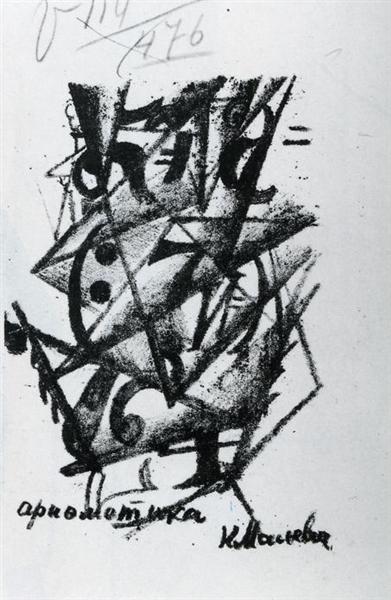Description
The "arithmetic" painting of 1913, created by the influential Russian artist Kazimir Malevich, is a work that reflects the stylistic transition that Malevich himself was going through in the years prior to the formulation of suprematism. Developed at a time when Cubism and futurism were in full in Europe, "arithmetic" shows the artist's ability to integrate and transcend these movements, creating a unique visual discourse that anticipates its evolution towards total abstraction.
At first glance, what attracts attention in "arithmetic" is the presence of simplified geometric forms and the structured disposition of the elements, which suggests a certain inclination towards mathematics and the rationality that the title already hints at us. On a smooth and monochromatic background grayish, Malevich displays a set of shapes that include rectangles, squares, and lines. This scheme not only facilitates an organized reading of the composition, but also invites the viewer to a deeper interpretation of the relationships between the empty forms and spaces.
The use of color is significant in this work: earthly tones such as brown, beige and ocher contrast with the gray of the bottom, allowing geometric figures to stand out in a way that seems almost three -dimensional. The color distribution follows a precise logic that, again, reinforces the idea of arithmetic or the science of numbers, as if the forms and colors themselves were part of a visual equation.
As for the characters, "arithmetic" stands out for their absence of human figures or any clear figurative representation. This choice highlights the Malevich approach in the purity of shapes and colors, moving away from the direct representation of the visible world to focus on the construction of an autonomous pictorial space. This vision not only challenges traditional pictorial perception, but also opens the way to a new way of understanding art as a free experience of the restrictions of the imitation of reality.
Kazimir Malevich is perhaps better known for his "Black Square" painting of 1915, which marks the culminating point of his search for pure abstraction. However, works such as "arithmetic" are essential to understand the evolution of their thinking and technique. In "arithmetic", we see how Malevich still works with forms that, although abstract, retain a relationship with the tangible world, a relationship that will soon abandon in its entirety in favor of suprematism, a movement that he would found.
In this context, "arithmetic" is not only a fascinating work of art, but also a testimony of a crucial moment in Malevich's trajectory. The series of geometric compositions and the strategic use of color in the work, indicate a transition from its cube-fouturist phase to a more radically abstract expression. The painting thus becomes a bridge between two worlds, standing out as an essential piece for those who seek to understand Malevich's unique contribution to modern art.
The importance of this work lies both in its aesthetic value and its historical significance, offering a window to the mind of an artist who was about to revolutionize the conception of art in the twentieth century. "Arithmetic" invites us to reflect not only on the principles of mathematics and geometry in painting, but also about the constant evolution and redefinition of what art can achieve.
KUADROS ©, a famous paint on your wall.
Hand-made oil painting reproductions, with the quality of professional artists and the distinctive seal of KUADROS ©.
Art reproduction service with satisfaction guarantee. If you are not completely satisfied with the replica of your painting, we refund your money 100%.

